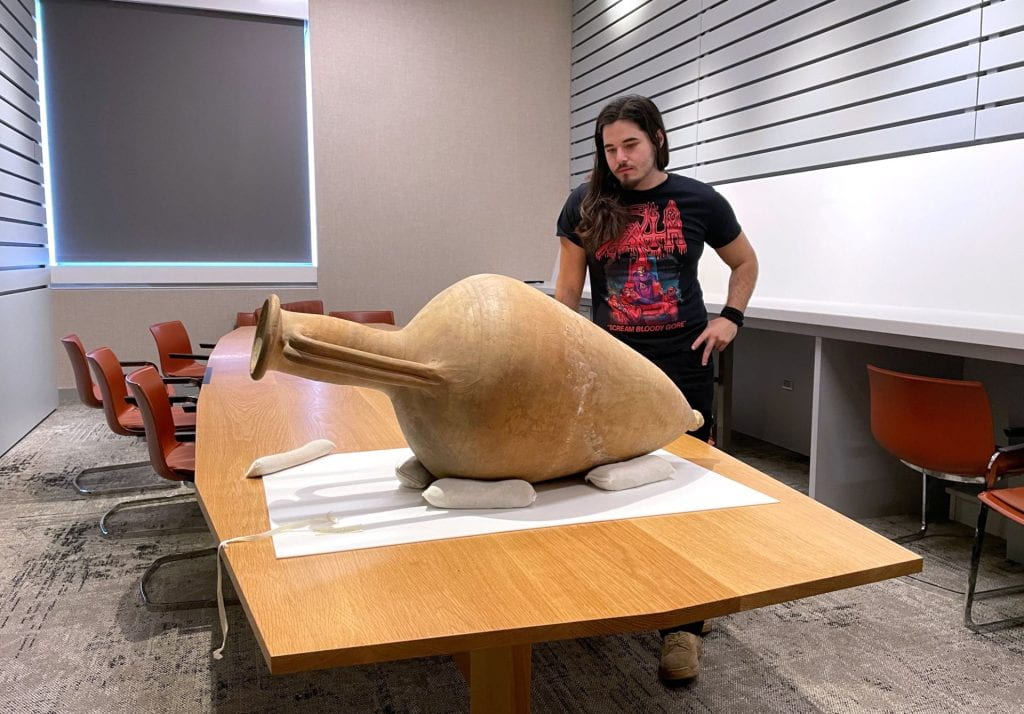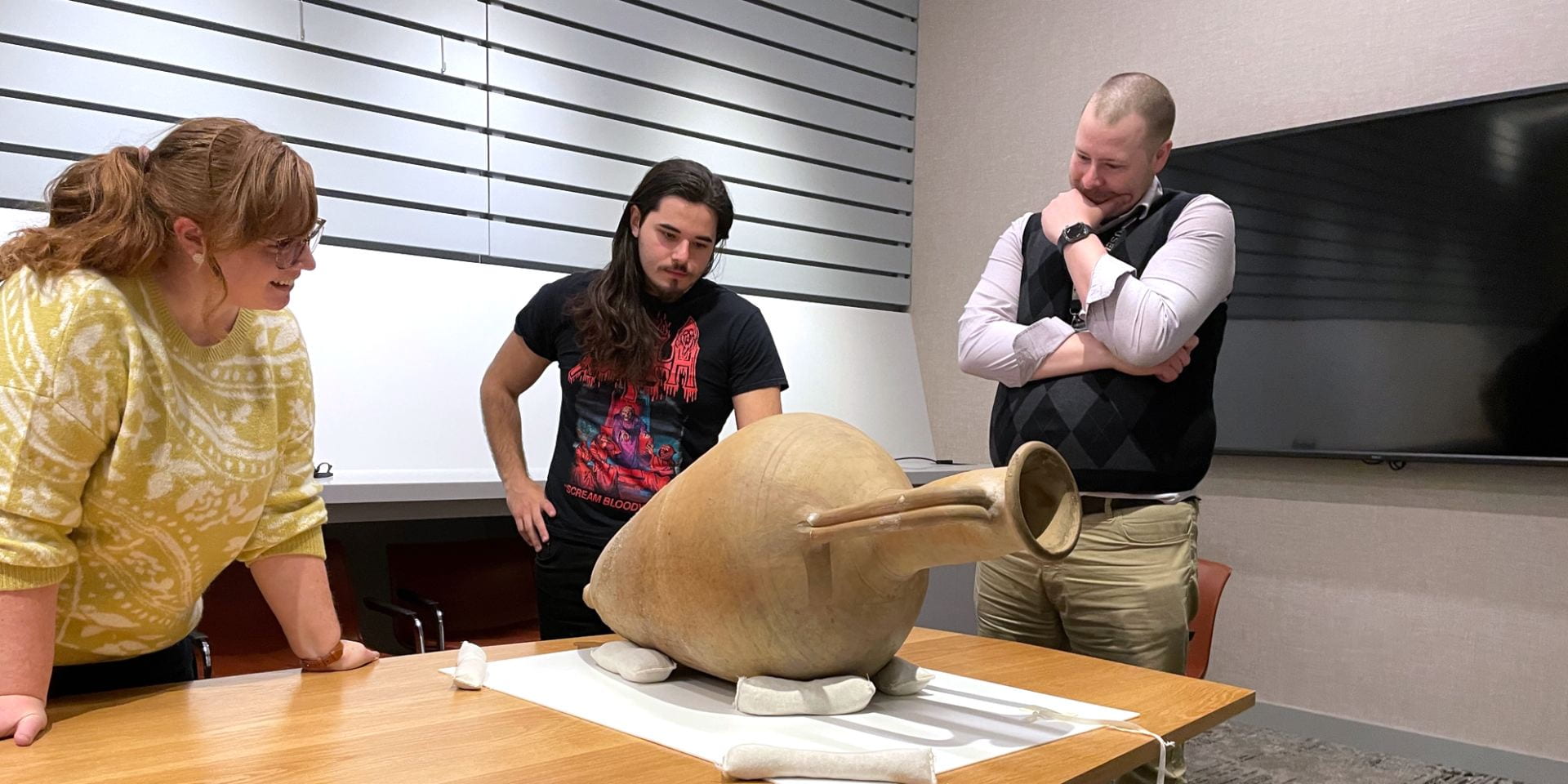The Hood Museum of Art is home to 65,000 objects, many of which were acquired by Dartmouth College long before the museum was even a thought in anyone’s mind. They were moved from building to building for decades, until they were settled on the shelves of our beloved Hood Museum. Since only a small portion of the museum’s collection makes it into the spotlight, over the years many of these objects have remained in storage, understudied and undisplayed. Such was the case with the Hood Museum’s Cypriot collection, which I worked on during my senior internship.

The Cypriot collection contains 422 objects that represent two millennia of history from the island of Cyprus. They were unearthed by Luigi Palma di Cesnola, an Italian-American diplomat turned archaeologist. He conducted several excavations on Cyprus in the late 19th century, and sold much of what was unearthed during these expeditions to the MET in New York City. Around 1872, Cesnola gifted another large group of archaeological finds to his friend and colleague Hiram Hitchcock, who was a trustee of Dartmouth at the time. The objects remained in the Hitchcock private collection until the 1912 passing of Hiram’s widow, Emily Howe Hitchcock, who had bequeathed the collection to the college.
The entirety of the Cypriot collection is in museum storage and until this year, most of it was unphotographed and incompletely cataloged on the museum’s website. I and my colleagues at the museum set out to remedy this situation by making the Cypriot collection more accessible to scholars, the public, and future researchers.
For several months, museum staff pulled objects from storage while I undertook the task of photographing them all, using the one tool that I always had on hand—my phone. The main goal was to efficiently capture as much of the collection as possible, and even though a phone might be a crude instrument for photography, it got the job done. Taking the pictures was only part of the task, however, and uploading them was an even more laborious endeavor.

Once I had uploaded the photographs, I still had to add to the images the tags and identifiers that would allow people to find these objects on the Hood Museum’s website. This quickly evolved into a research project, as we wanted to make sure that all the objects were labeled specifically, precisely, and consistently. I pulled dozens of catalogs from the library to find comparanda and standardized naming conventions for the objects. During this research, I found that some of their previously assigned dates were not accurate. So, within a short time, the undertaking grew from taking photographs to filling in data fields—a job that I personally found quite satisfying.
This entire project wasn’t as straightforward as one might have wished. Sometimes we would encounter objects that were apparently unique since they were without direct comparanda. Other times, we would be faced with works that hadn’t been looked at in decades and therefore required us to really dig to find useful leads. Even with these challenges, it was exciting to know that these wonderful artifacts were finally getting the attention they deserved.

One particularly interesting object that I had a chance to look at was a large Cypriot amphora. This vessel had almost no information in our system. We knew that it was large, but we had no dimensions for it. We also knew that it had found its way into the museum’s collection along with the other Cypriot objects, but that was all that was known about its provenance. When we pulled it from storage for photography, I can honestly say that we were dumbfounded by how large it was—three and a half feet tall and so wide that you’d have a hard time wrapping your arms around it. Even more impressive was that it was intact. We wanted to discover as much as we could about this amphora, so I set out on doing some research. After a day of trudging through old excavation reports, looking through amphora typologies, and bouncing some emails to experts on ancient amphorae, we were able to conclude from its shape and features that it dated to the third century BCE and that it was made on Kos, an island 364 miles away from Cyprus! It was amazing to think of the journey this amphora went through, traveling miles and miles in antiquity, and eventually making its way to our doorstep in Hanover, NH, more than 2000 years later. What’s even more remarkable is that we were able to reconstruct such a detailed profile on this object given the limited information we had initially. This was the object that I think really highlighted the importance of this project.
These past few months I have come to recognize how different museum work is from archaeological fieldwork, to which I am more accustomed. Getting to experience the inner workings of a museum, the sort of “behind-the-scenes” action that takes place in the annexes, allowed me to gain a new perspective on archaeology. I appreciated seeing both how digging in the trenches compares to working with objects in storage and how the jobs differ from but also complement one another. Conducting collections research made me realize how important it is to follow proper archaeological procedures when excavating. If an archaeologist fails to document finds, as was often the case with Cesnola, it makes the job of the museum researcher much more difficult. Likewise, if a museum does a poor job of organizing, cataloging, and displaying its ancient collections in an accessible manner, the value of the work of the archaeologist is diminished. I have truly begun to understand through this internship that effective cooperation and communication between these two fields is vital for preserving, understanding, and displaying material culture.

I am grateful that I was able to further our understanding of the past and make it more accessible to the world. I would encourage everyone to do as I did: to broaden their horizons and contribute what they can, however they can, to increasing collaboration among different academic and professional disciplines.
I would like to extend a big thank you to my colleagues at the museum who aided me in this project, especially Beth Mattison and Randall Kuhlman, to my advisor in the Classics department, Professor Julie Hruby, and to all of the experts who helped me with my research along the way. This project would not have been possible without your help.
This post was authored by: Hood Museum of Art Conroy Intern Gabriel Margaca ’23
 ABOUT THE AUTHOR
ABOUT THE AUTHOR
Gabe was the Conroy Intern during his senior year at Dartmouth. He graduated in June 2023, with a major in classical archaeology and a double minor in art history and Italian. In addition to his extensive work on the Hood’s Cypriot collection, he has also worked on an exhibition catalogue for an upcoming exhibition Living with Sculpture, which will focus on the intersection between sculpture and life in the early modern period. After graduating, Gabe has intentions of continuing his studies and pursuing an MA in mediterranean archaeology, at the Sapienza University in Rome.

Comments